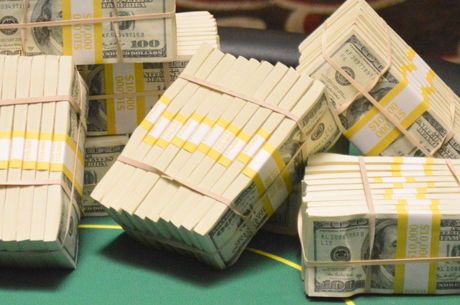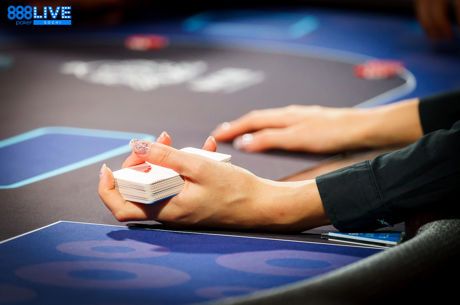Strategy Vault: Side Pot Hand Analysis with Adam Geyer

Digging deep into the PokerNews strategy archives can unearth some buried treasure for seekers of strategy gems. In this edition of the Strategy Vault, we look back to share some advice given to us by Adam Geyer concerning the special strategic issues that can arise when vying for a side pot.
At the time we spoke with Geyer about this tournament hand, he had already made a name for himself both in the live arena and online where as “csimmsux” he could frequently be found crushing FTOPS events on Full Tilt. Since then he has continued to add to his career live earnings, pushing up close to $1.7 million after another successful year that included four cashes at the 2015 World Series of Poker.
The following hand came from relatively deep in a $150,000 guaranteed tournament Geyer played on Full Tilt. They had already reached the money and with about 100 players left Geyer found himself involved in a three-way hand in which a short-stacked player being all in before the flop affected his decision-making versus a lone remaining opponent.
Stakes: 3,000/6,000 with a 400 ante
Stack Sizes:
Adam Geyer - 247,056
Small Blind - 1,434
Big Blind - 55,055
Preflop: It folded around to Geyer who min-raised to 6,000 with K♥J♠. It folded to the small blind who was already all in, and the big blind called Geyer’s raise.
What is your thinking about the situation before the flop comes?
The small blind is crippled and is all in blind this hand. The big blind has shown that he’s not quite sure what's going on, so with my big stack, it’s a normal open. The big blind called, putting about 8,000 to 9,000 in the main pot and 7,500 in the side.
Flop: The flop comes 8♣7♣6♥. The big blind checks, Geyer bets 7,502, and the big blind calls.
You have decided to continue with a bet into the side pot. What are your thoughts?
I continuation bet, assuming he’ll fold a decent amount of the time as people tend to fold a little more when there is a player all in. Conventional/random player thinking is that, “He must have it since there is a player all-in and, dammit, he better have it so we can eliminate him!” His call surprises me, as I would expect him to check-raise all in with anything he is calling with, given his short stack. But he calls, so I suspect he has a mediocre one pair hand and/or some kind of draw.
Turn: The turn is the 3♦. The board now reads 8♣7♣6♥3♦. The big blind checks, and Geyer checks as well.
Here you slow down and check behind. Talk about your thinking here.
I tanked for a bit, trying to decide if I should bet the turn small, put him all in, or check back. He has an awkward stack for this spot, and the three is a brick. I figured if I bet small he’s going to call again, and then be priced in to call with any pair on the river, so I ruled that option out. Putting him all in seemed risky, as he might be in love with 9x7x or something, and [it seemed] a bit much to shove. So I checked, ready to reevaluate the river. In hindsight though, I think a shove might have been better.
River: The river is the A♦, making the final board 8♣7♣6♥3♦A♦. The big blind bets 3,000, and Geyer moves all in. The big blind folds, and Geyer wins the pot.
Explain your river shove.
The river was a great card to represent. He quickly bet the minimum, which screamed to me he only had a seven or something and was just trying to block with a small bet. If he had bet more like a quarter or third of the pot as many people would, the stacks would’ve made it a harder shove. But he did not, so I shoved and he quickly mucked. The short stack had flopped a straight for the tiny main pot, but oh well.
These side-pot spots are always kind of interesting in that people used to always just check down their hands so they could eliminate the third party easier. I used to see many people yell at the aggressor like I was here, and say, “What are you doing? He would have been knocked out!”
But by checking down, you’re sacrificing your own EV in the pot, which is far more important to you than if you suddenly go from 113 players to 112 like in this spot. Obviously it’s different if you're at a final table with a big pay jump in play, but in general, it’s far better to play the hand as if the third player isn’t there. His presence does add another dynamic to the hand that good players can use to their advantage.
What other rivers are you raising after a min-bet? A queen? Do you raise a king or jack for value, or just call the bluff/block bet thinking no worse hands call your shove?
I would have raised a king or jack real small on the end for value, because I think he would have called a small raise with one pair. If a straight- or flush-type card came out and he made the same bet, I would have shoved as well, as I would assume this player would bet more than a tenth of the pot with a flush or straight himself. If another stone brick came out, I’m not sure what I would have done to his bet. I would probably still shove, but he’s going to call a lot more often.
Can elaborate on why you think shoving the turn is better now that you look back at the hand?
Hindsight might be playing into me thinking it would have been better to push the turn now, as it’s quite clear he had a second- or third-pair type hand. At the time, I think I just didn’t like the stack sizes and thought he might spew with a bunch of hands. But I should have known when he didn’t check-raise all in, he was pretty mediocre and couldn’t stand to call a shove, or at least he shouldn’t.
When is it actually correct to check it down when a player is all in? When there is no side pot or a very small one?
When there is no side pot or a very small one and you have something that absolutely can’t win the main pot — like it got checked down to the end, and you have a missed draw — then you might as well check down and hope the other guy can take it.
But if you flop any pair or have a big draw, then I think you should bet because you’ll usually get heads-up with the all-in player, and you would much rather have your third pair, ace-high, or a hand with some sort of showdown value versus one opponent than two. You might as well not let the other guy get there and win the pot with something random, when you could’ve been heads-up with the all-in guy and beat him with a worse hand, if that makes sense. The concept is that your own equity heads-up versus a random hand is so much more valuable than going three-ways and eliminating one random short stack.
However, if you’re at the Main Event final table or whatever, you would be more inclined to check down far bigger hands because each elimination means many direct dollars.
Want to stay atop all the latest in the poker world? If so, make sure to get PokerNews updates on your social media outlets. Follow us on Twitter and find us on both Facebook and Google+!










